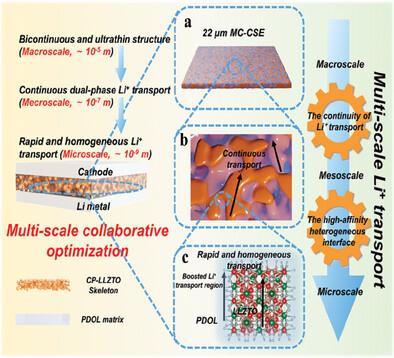Multiscale Collaborative Optimization for Composite Solid Electrolyte to Achieve High-Performance Lithium Metal Batteries
IF 13
2区 材料科学
Q1 CHEMISTRY, MULTIDISCIPLINARY
引用次数: 0
Abstract
Composite solid electrolytes (CSEs) possess significant advantages over individual polymer or inorganic solid electrolytes. However, conventional CSEs suffer from multiple scale issues, including interruptions in ionic transport pathways, incompatibility at heterogeneous interface, and the excessive thickness of electrolytes. Herein, a novel CSE with ultrathin structure (22 µm) based on the strategy of multiscale collaborative optimization (MC-CSE) is designed. This strategy involves continuous, rapid, and homogeneous Li+ transport from macroscale to microscale. i) The bicontinuous structure of MC-CSE is constructed via in situ polymerization of 1,3-dioxolane in a continuous yet porous Li6.4La3Zr1.4Ta0.6O12 (CP-LLZTO) skeleton, which effectively reduces the barrier for Li⁺ transport at macroscale. ii) The continuous interconnected CP-LLZTO and poly 1,3-dioxolane (PDOL) phases within MC-CSE ensures continuous Li+ transport at mesoscale. iii) CP-LLZTO and PDOL synergistic interaction at heterogeneous interface, which facilitates the rapid and homogeneous Li+ transport at microscale. Consequently, the MC-CSE shows both high ionic conductivity and Li⁺ transference number (1.04 mS cm−1 and 0.87). The cells assembled with MC-CSE exhibit outstanding low-temperature (−20 °C) and high-voltage (4.5 V) performance. The strategy of multiscale collaborative optimization provides a promising perspective for the viability of lithium metal batteries at various conditions.

求助全文
约1分钟内获得全文
求助全文
来源期刊

Small
工程技术-材料科学:综合
CiteScore
17.70
自引率
3.80%
发文量
1830
审稿时长
2.1 months
期刊介绍:
Small serves as an exceptional platform for both experimental and theoretical studies in fundamental and applied interdisciplinary research at the nano- and microscale. The journal offers a compelling mix of peer-reviewed Research Articles, Reviews, Perspectives, and Comments.
With a remarkable 2022 Journal Impact Factor of 13.3 (Journal Citation Reports from Clarivate Analytics, 2023), Small remains among the top multidisciplinary journals, covering a wide range of topics at the interface of materials science, chemistry, physics, engineering, medicine, and biology.
Small's readership includes biochemists, biologists, biomedical scientists, chemists, engineers, information technologists, materials scientists, physicists, and theoreticians alike.
 求助内容:
求助内容: 应助结果提醒方式:
应助结果提醒方式:


